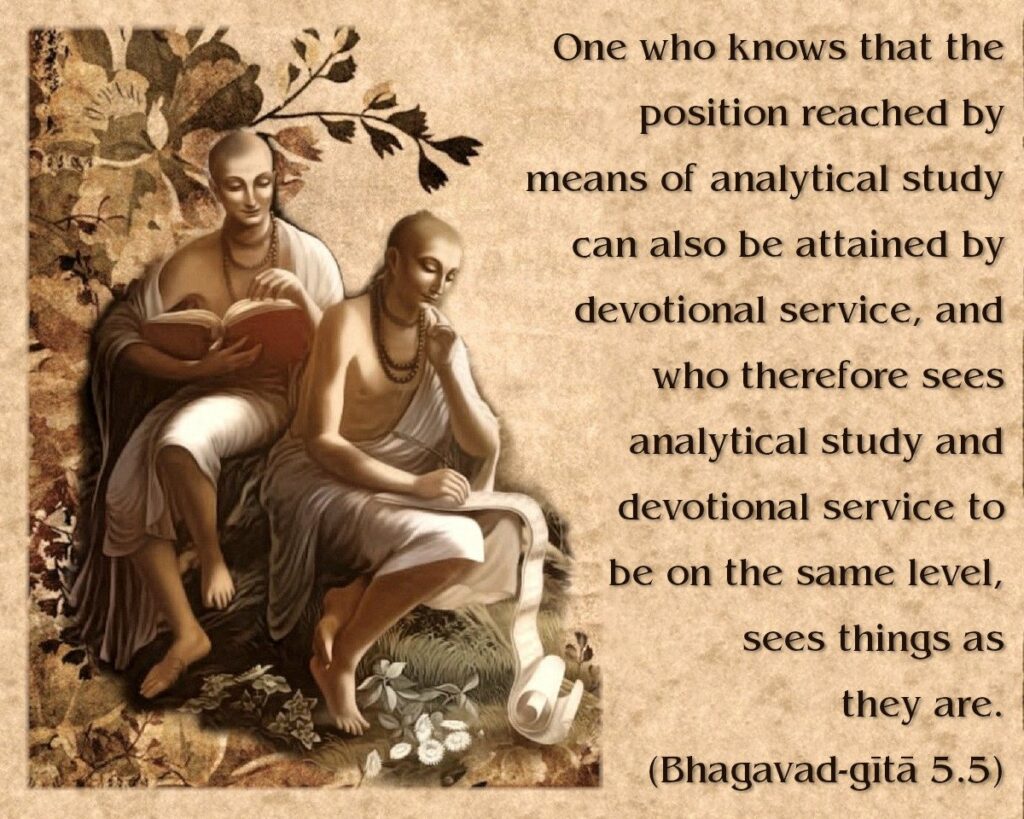यत्साङ्ख्यै: प्राप्यते स्थानं तद्योगैरपि गम्यते |
एकं साङ्ख्यं च योगं च य: पश्यति स पश्यति || 5||
yat sānkhyaiḥ prāpyate sthānaṁ tad yogair api gamyate
ekaṁ sānkhyaṁ cha yogaṁ cha yaḥ paśhyati sa paśhyati
yat—what; sānkhyaiḥ—by means of karm sanyās; prāpyate—is attained; sthānam—place; tat—that; yogaiḥ—by working in devotion; api—also; gamyate—is attained; ekam—one; sānkhyam—renunciation of actions; cha—and; yogam—karm yog; cha—and; yaḥ—who; paśhyati—sees; saḥ—that person; paśhyati—actually sees
Translation:
That state (Moksha) reached by men of Knowledge is also reached by men of Action (Karma yogis). He who sees the oneness of Jnana and Karma, really sees.
Commentary:
The Lord reiterates the unity of Jnanayoga and Karmayoga in regard to the ultimate goal. The wise man sees the truth behind each sadhana and knows that though they are outwardly different, they are leading to the same consummation. It is only the ignorant who imagine that one path is superior to the other. These paths are intended to serve the needs of different aspirants born with different tendencies, and previous samskaras. One can reach any part of the globe by going east or west. Similarly one can reach the spiritual goal by anyway. The harmonisation of different systems and creeds is the purpose of the Gita. At every step, the teacher of the Gita insists on the fact that the goal is the same, and explains the different paths from that standpoint. Hence the Gita is universal in its appeal to all mankind.
Sri Ramakrishna Says —
“He who is called Brahman by the jnanis is known as Atman by the yogis and as Bhagavan by the bhaktas. The same brahmin is called priest, when worshipping in the temple, and cook, when preparing a meal in the kitchen. The jnani, sticking to the path of knowledge, always reasons about the Reality, saying, ‘Not this, not this’. Brahman is neither ‘this’ nor ‘that’; It is neither the universe nor its living beings. Reasoning in this way, the mind becomes steady. Then it disappears and the aspirant goes into samadhi. This is the Knowledge of Brahman. It is the unwavering conviction of the jnani that Brahman alone is real and the world illusory. All these names and forms are illusory, like a dream. What Brahman is cannot be described. One cannot even say that Brahman is a Person. This is the opinion of the jnanis, the followers of Vedanta philosophy.
“But the bhaktas accept all the states of consciousness. They take the waking state to be real also. They don’t think the world to be illusory, like a dream. They say that the universe is a manifestation of God’s power and glory. God has created all these — sky, stars, moon, sun, mountains, ocean, men, animals. They constitute His glory. He is within us, in our hearts. Again, He is outside. The most advanced devotees say that He Himself has become all this — the twenty-four cosmic principles, the universe, and all living beings. The devotee of God wants to eat sugar, not to become sugar. (All laugh.)
“Do you know how a lover of God feels? His attitude is: ‘O God, Thou art the Master, and I am Thy servant. Thou art the Mother, and I am Thy child.’ Or again: ‘Thou art my Father and Mother. Thou art the Whole, and I am a part.’ He doesn’t like to say, ‘I am Brahman.’
“The yogi seeks to realise the Paramatman, the Supreme Soul. His ideal is the union of the embodied soul and the Supreme Soul. He withdraws his mind from sense-objects and tries to concentrate it on the Paramatman. Therefore, during the first stage of his spiritual discipline, he retires into solitude and with undivided attention practises meditation in a fixed posture.
“But the Reality is one and the same. The difference is only in name. He who is Brahman is verily Atman, and again. He is the Bhagavan. He is Brahman to the followers of the path of knowledge, Paramatman to the yogis, and Bhagavan to the lovers of God.” (Source: Gospel of Sri Ramakrishna)
The worshipful Lord said: I have proclaimed three types of communion for the spiritual enlightenment of man. These are the Yogas of Jnana, Karma and Bhakti. There is no other way besides these three. (Srimad Bhagavatam 11.20.6)
Question: Who is the wise man?
Answer: The sage who knows that Jnanayoga and Karmayoga lead to the same state (Moksha) is the wise man.
Bhagavad Gita: Chapter 5 🔻 (29 Verses)
